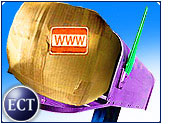
In Part 1 of this primer for small offline businesses that want to go online, we saw how much planning is involved in making the move, from selecting the inventory that will be sold, to choosing which companies will design and host the site.
In Part 2, we learn that setting up an e-tail outlet also requires careful consideration of several other details, including layout, content, security — even the URL. Following on the points addressed in Part 1, let’s take a look now at the other factors a small business must address before going live on the Web with a new e-commerce arm.
5) Host Your Own
Web developer John Allen said that if at all possible, retailers should get their own domain name and avoid hosting their e-tail site at a free server such as Geocities.
“The URL itself is going to tell users a lot about you,” Allen said. “Quite frankly, your more savvy users are going to look at a Members.AOL or Geocities URL and they’re going to think you are a small-time nobody. Geocities and AOL are better used for personal sites.”
6) Mellow for Fellow Newbies
Allen and independent business consultant Jeffrey Moses agree that a well-designed, easy-to-navigate site is crucial to online success. Products should be easy to find and to purchase, and there should be an easy way for consumers to return to the home page.
Allen said that the site should be designed “so a newbie can use it,” and added that a contact page is also critical.
“If online consumers can’t contact someone by phone, they’re going to get skittish,” he said.
7) Don’t Deck the Halls
New e-tailers also have to remember that not every consumer has the latest bells and whistles on his or her computer. Some online consumers connect at slow speeds and with older computers that simply cannot handle intensive graphics and audio.
Allen advised retailers who want to incorporate flashy graphics and sound into their sites to offer consumers the option of viewing a straight HTML site.
After a site is completed, it should be thoroughly tested to make sure it works properly, experts said. Ideally, retailers should test the site from a number of different computers and Internet connections to make sure it works under a variety of conditions.
8) Check Your Budget
Developing a Web site is not only time consuming, it also costs money — sometimes a lot of money. A recent report by the National Federation of Independent Business (NFIB) found that 8 percent of small businesses surveyed spent US$10,000 or more on their site development.
However, at the other end of the spectrum, 35 percent of small businesses reported spending $1,000 or less.
Notably, 35 percent of those surveyed were unable to determine how much it cost to build their site, because the costs of developing the site were lumped with other expenses, such as advertising, promotion or computers.
Most companies surveyed by the NFIB found that site maintenance was not a large expense. Thirty-four percent of respondents said the cost of site maintenance was $50 a month or less, and 8 percent listed expenses ranging from $50 to $99 a month. Only 11 percent reported spending $500 a more on site maintenance.
9) Get the Word Out
Once a site is up and running, virtual shopkeepers need to let customers know about it. But how should they get the word out?
Gartner research director David Schehr points out that because the Web is so vast, it is difficult and costly for small retailers to reach new customers — the exception being niche retailers that might be able to advertise effectively on specialty sites. For instance, a small mystery bookstore would have a good chance of reaching potential buyers by advertising on a Web site for mystery aficionados.
One sensible form of online advertising, according to Schehr, is the search engine. Schehr advised new e-tailers to get listed in as many search engines as possible. He also recommended taking the time to collect customers’ e-mail addresses, in order to send them notifications of upcoming sales or specials.
Of equal or greater importance, according to Schehr and Yankee Group director of Internet market strategies Michele Pelino, is for brick-and-click retailers to print their Web address on every piece of promotional material that leaves their store, from flyers to shopping bags.
10) Build Loyalty
Building a successful e-tail business does not end when the site is up and running. E-tailers need to provide an incentive for customers to come back. One way to do this, according to Moses, is to include informative content and update your site regularly.
“Focus on giving information to customers,” Moses said. “And in the process you’ll create more loyal customers.”
Supplying an easy way for customers to return items purchased online will also build customer loyalty, according to Pelino. She also suggested offering returning customers incentives, in the form of discounts or specials.
In the end, according to Moses, the retailers that successfully turn their offline success into online success will be those who are “prudent and cautious” and move online slowly.
















































What about accepting payment for goods and services? I suggest taking a look at Paymentplus’ LiveProcessor software!